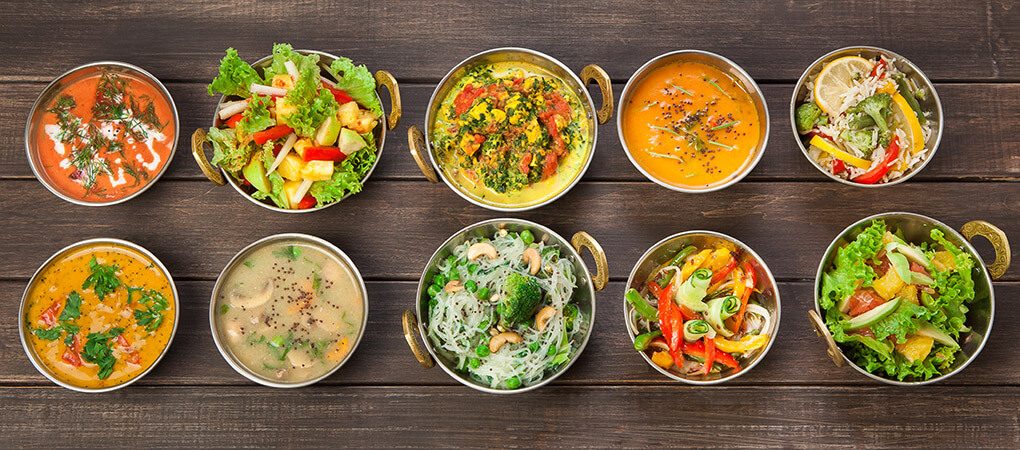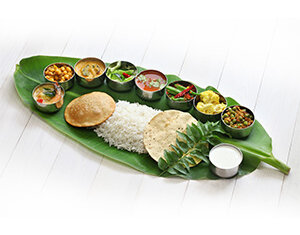Blog
6 Different Types of Taste & Their Roles According to Ayurveda
Ayurvedic Diet

Ayurveda in India lays great emphasis on taste. Also, known as rasa in Sanskrit, taste can be defined in a number of ways. Experience, enthusiasm, essence and juice, all form an integral part of taste. The 6 tastes that Ayurveda identifies are as follows:
- Sweet taste
- Sour taste
- Salty taste
- Spicy (pungent taste)
- Bitter taste
- Astringent taste
Each taste possesses a different property and render different benefit to the body while playing a vital role in the digestion process. A balance or a mix of all these tastes is what makes the experience of eating and tasting the food palatable. Each taste in the aforementioned lists of taste are a combination of two of the five elements mentioned in Ayurveda. Their unique property reflects in their predominant elements and act on the body as per the three doshas. For example, the sweet taste is a combination of the elements of earth and water, which are the same elements that make up the kapha dosha. For those with kapha dosha, sweet taste can lead to an increase in kapha dosha and qualities of heaviness, coolness, slowness and stickiness. On the other hand, sweet taste in those with vata dosha , when taken in moderate quantities, can prove to have a positive effect on the health and balance out disorders.
Different Types Of Tastes As Per Ayurveda:
The moment the food reaches our mouth, the first thing that strikes about it is its taste. Good or bad, palatable or unpalatable, it is the taste that makes us decide whether we would want to further swallow/eat that thing or not. But did you know that taste also has a connection to the digestion process of whatever we eat? The saliva in the mouth contains enzymes that further help in breaking down of the food into carbohydrates before we swallow it. Once one of the earlier mentioned six tastes has been identified by the brain, it signals the gut or the digestive tract to secret the specific enzymes that would be required for proper digestion. It is for this particular reason that we are always advised to eat our food with proper attention and savor every bite of it.
It is not that difficult to obtain a sense of these 6 tastes. But one needs to know that misuse of this sense can lead to diminish of their effect on your health and cause an imbalance in the digestive system. For example, if a person with kapha dosha indulges in too many sweets, it can lead to the problem of obesity and diabetes in him. Similarly, if a person with pitta Dosha consumes foods with sour taste, it can lead to increase in digestive problems in them.
Here’s your guide to understanding the 6 tastes as prescribed in Ayurveda:
- Sweet taste :
Comprising the elements of earth and water, sweet taste balances vata and pitta dosha in the body and increases kapha dosha. Of the six types of tastes, this one is said to be the most nourishing. When taken in moderation, they are known to provide you with longevity, strength and healthy body fluids. But remember to not go overboard with it as it can lead to health conditions like weight gain, obesity, and diabetes among others.
Sweet taste is prominent in food items like wheat, rice, pumpkin, maple syrup etc. - Sour taste :
Consisting of the elements of water and fire, it is known to stimulate pitta and kapha dosha in the body and decrease the vatadosha. Foods with sour taste are also known to increase appetite and production of saliva. Of the six different types of tastes that exist, sour taste is known to awaken thoughts and emotions and improve digestion. It needs to be taken in moderation else can lead to aggression in the body in no time. Some of the sour taste food items are lemon, vinegar, pickled vegetables and tamarind among others. - Salty taste :
Salty taste consists of the elements of earth and fire and leads to decrease of vata and increase of pitta and kapha doshas. Because of its hydrating nature, of the 6 tastes in Ayurveda, salty taste aids in digestion and cleansing of the tissues. But too much of it can also lead to increase in blood pressure and have impact on your skin and blood. So, it’s intake in moderation is recommended. Examples of salty tasting foods are sea vegetables, sea salt, and black olives among others. - Spicy (pungent taste) :
Pungent taste consists of the elements of fire and air and of the 6 tastes in Ayurveda, it is the hottest and so is known to aid digestion, improve appetite, cleanse tissues and enhance blood circulation. Pungent taste also helps in balancing of kapha but if had in more than prescribed quantitates can aggravate pitta and lead to other health related issues. Vata handles pungent taste when combined with sweet, sour or salty foods. Some of the best examples of spicy foods are chilies, garlic, ginger, hot peppers and onions etc. - Bitter taste :
Bitter taste is made up of the elements of air and space and is considered to be the coolest of all the six tastes. Naturally detoxifying in nature, it helps remove waste and toxic material from the body and purifies the body. Bitter taste is best suited for pitta and kapha doshas and least beneficial bodies with vatadosha. Turmeric, green vegetables, and herbal teas fall in the category of foods with bitter taste. - Astringent taste :
Made up of air and earth elements, astringent taste is said to be cool, firm and dry. People with vata are advised to consume less of astringent taste as it can lead to problem of gas in them. It benefits people with pitta dosha. Unripe bananas, cranberries, and green beans etc., are said to have astringent taste.
While it would be difficult to adjust all the types of tastes mentioned here in every meal, a combination of two or three of these six tastes will help you maintain a balance in your ayurvedic diet as well as health.












